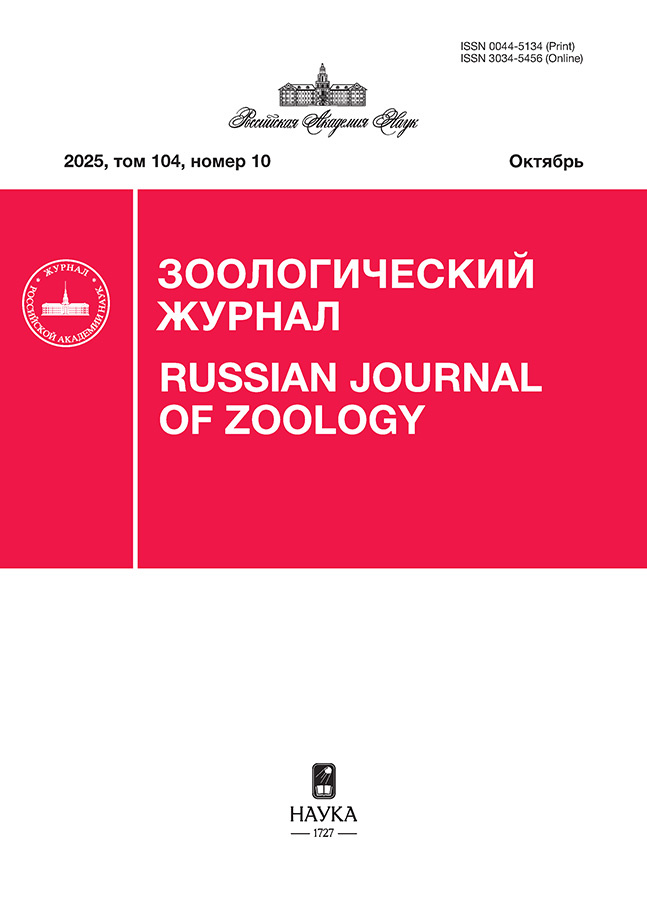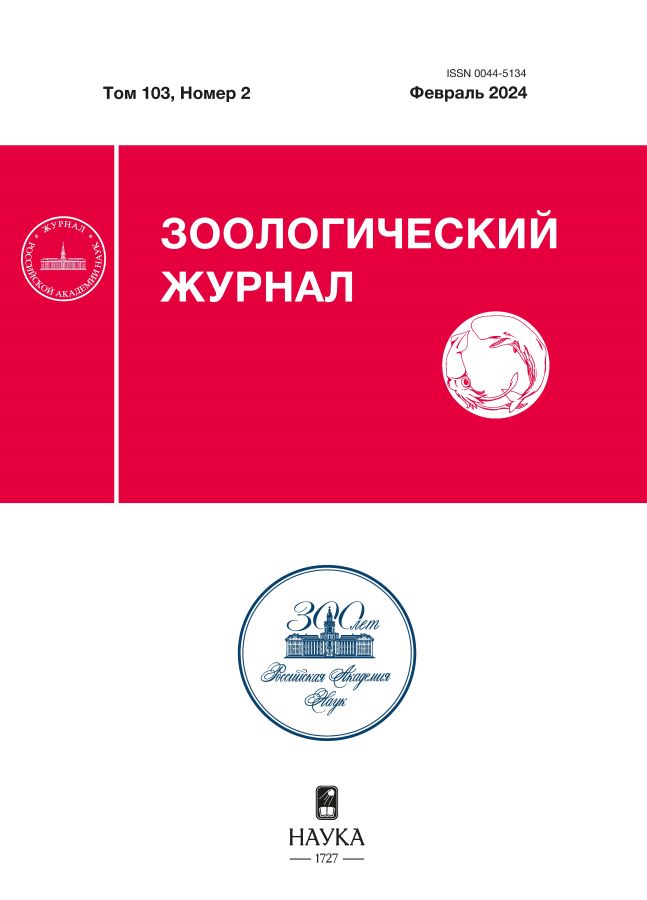Количественный анализ изменчивости и корреляции элементов коронки верхних щёчных зубов обыкновенного бобра (castor fiber, rodentia, castoridae) на основе геометрической морфометрии
- Авторы: Павлинов И.Я.1
-
Учреждения:
- Научно-исследовательский зоологический музей МГУ имени М. В. Ломоносова
- Выпуск: Том 103, № 2 (2024)
- Страницы: 111-120
- Раздел: Методика зоологических исследований
- URL: https://stomuniver.ru/0044-5134/article/view/654322
- DOI: https://doi.org/10.31857/S0044513424020105
- EDN: https://elibrary.ru/VWAAVA
- ID: 654322
Цитировать
Полный текст
Аннотация
Индивидуальная и возрастная изменчивость элементов коронки верхних щёчных зубов и их корреляции изучены у грызунов рода Castor на основе “элементаристского” описания зубной коронки с помощью геометрической морфометрии и с использованием корреляционного, кластерного и дисперсионного анализов. Описан базовый алгоритм сравнения элементов коронки внутри каждого зуба и между зубами по указанным характеристикам. Наименьшая индивидуальная изменчивость характерна для зубов, занимающих среднее положение в щечном зубном ряду. Не выявлено четкой зависимости уровней индивидуальной вариабельности элементов коронки ни от их положения в зубной коронке, ни от их сложности. Возрастные различия в форме этих элементов иногда могут быть очень значительными, причем молодые особи наиболее специфичны в этом отношении. Наименее индивидуально изменяющиеся зубные единицы (либо зубы целиком, либо отдельные элементы), как правило, оказываются наиболее изменчивыми с возрастом, хотя этот результат может носить чисто “статистический” характер. Корреляции между элементами зубной коронки в целом не очень высокие, причем корреляции внутри зубов в среднем несколько сильнее, чем между зубами. Корреляции, как правило, сильнее у взрослых, чем в других возрастных группах. Корреляции между элементами зубной коронки меняются с возрастом и в этом отношении существенно различаются. Показано, что общие тенденции возрастных различий в корреляциях противоположны для внутри- и межзубных сравнений. Общие уровни корреляций и диапазоны их возрастных различий находятся в обратной зависимости. Общая закономерность корреляции элементов зубной коронки более очевидна в комбинированной возрастной группе (полувзрослые + взрослые). Дальнейшие исследования как изменчивости, так и корреляционной структуры зубных рядов млекопитающих следует проводить на основе “элементаристского” описания зубной коронки.
Полный текст
Об авторах
И. Я. Павлинов
Научно-исследовательский зоологический музей МГУ имени М. В. Ломоносова
Автор, ответственный за переписку.
Email: igor_pavlinov@zmmu.msu.ru
Россия, ул. Большая Никитская, д. 2, Москва, 125009
Список литературы
- Adams D.C., 2015. Evaluating modularity in morphometric data: challenges with the RV coefficient and a new test measure // Methods in Ecology and Evolution. V. 5. № 5. З. 565–572.
- Ackermann R.R., 2002. Patterns of covariation in the hominoid craniofacial skeleton: implications for paleoanthropological models // Journal of Human Evolution. V. 42. № 1. P. 167–187.
- Bardua C., Felice R.N., Watanabe A., et al., 2019. Practical guide to sliding and surface semilandmarks in morphometric analyses // Integrative Organismal Biology. V. 1. № 1. obz016 [An electronic source]. Accessed through: https://academic.oup.com/iob/article/1/1/obz016/5526881?login=false. The last upgrade date: 05.07.2019
- Вoivin M., Alvarez A., Ercoli M.D., 2022. Integration patterns of cheek teeth and ecomorphological evolution in grinding herbivores: the case of caviine rodents (Caviomorpha: Caviidae) // Zoological Journal of the Linnean Society. V. 196. № 3. zlac005 [An electronic source]. Accessed through: https://doi.org/10.1093/zoolinnean/zlac005. The last upgrade date: 12.03.2022.
- Bolker J.A., 2000. Modularity in development and why it matters to evo-devo // American Zoologist. V. 40. № 5. P. 770–776.
- Callebaut W., Rasskin-Gutman D. (eds), 2005. Modularity: understanding the development and evolution of complex natural systems. Cambridge: MIT Press 472 p.
- Cardini A., Loy A., 2013. On growth and form in the “computer era”: from geometric to biological morphometrics // Hystrix, Italian Journal of Mammalogy. V. 24. № 1. P. 1–5.
- Cheverud J.M., 1996. Developmental integration and the evolution of pleiotropy // American Zoologist. V. 36. № 1. P. 44–50.
- Gingerich P.D., 1974. Size variability of the teeth in living mammals and the diagnosis of closely related sympatric fossil species // Journal of Paleontology. V. 48. № 5. P. 895–903.
- Gingerich P.D., Schoeninger M.J., 1979. Patterns of tooth size variability in the dentition of Primates // American Journal of Physical Anthropology. V. 51. № 3. P. 457–465.
- Gkantidis N., Halazonetis D.J., 2011. Morphological integration between the cranial base and the face in children and adults // Journal of Anatomy. V. 218. № 4. P. 426–438.
- Gόmez-Robles A., Polly P.D., 2012. Morphological integration in the hominin dentition: evolutionary, developmental, and functional factors // Evolution. V. 66. № 4. P. 1024–1043.
- Goswami A., Polly P.D., 2010. Methods for studying morphological integration, modularity and covariance evolution // The Paleontological Society Papers. V. 16. № 2. P. 213–243.
- Gould S.J., Garwood R.A., 1969. Levels of integration in mammalian dentitions: an analysis of correlations in Nesophontes micrus (Insectivora) and Oryzomys couesi (Rodentia) // Evolution. V. 23. № 2. P. 276–300.
- Hallgrímsson B., Jamniczky H., Young N.M., et al., 2009. Deciphering the palimpsest: Studying the relationship between morphological integration and phenotypic correlation // Evolutionary Biology. V. 36. № 4. P. 355–376.
- Hammer Ø., Harper D., Ryan P.D., 2001. PAST. PAleontological STatistics software package for education and data analysis // Palaeontologia Electronica. V. 4. № 1. P. 1–9.
- Hayes J., P., Jenkins S.H., 1997. Individual variation in mammals // Journal of Mammalogy. V. 78. № 2. P. 274–293.
- Jung H., Simons E., von Cramon-Taubadel N., 2021. Ontogenetic changes in magnitudes of integration in the macaque skull // American Journal of Physical Anthropology. V. 174. № 1. P. 76–88.
- Klingenberg C.P., 2009. Morphometric integration and modularity in configurations of landmarks: Tools for evaluating a priori hypotheses // Evolution & Development. V. 11. № 4. P. 405–421.
- Klingenberg C.P., 2014. Studying morphological integration and modularity at multiple levels: concepts and analysis // Philosophical Transactions of the Royal Society B: Biological Sciences. V. 369. № 1649. P. 20130249. doi: 10.1098/rstb.2013.0249
- Klingenberg C.P., Marugán-Lobón J., 2013. Evolutionary correlation in geometric morphometric data: analyzing integration, modularity, and allometry in a phylogenetic context // Systematic Biology. V. 62. № 4. P. 591–610.
- Korth W.W., 2002. Comments on the systematics and classification of the beavers (Rodentia, Castoridae) // Journal of Mammalian Evolution. V. 8. № 4. P. 279–296.
- Labonne G., Navarro N., Laffont R., et al., 2014. Developmental integration in a functional unit: deciphering processes from adult dental morphology // Evolution & Development. V. 16. № 4. P. 224–232.
- Lawing A.M., Polly P.D., 2010. Geometric morphometrics: recent applications to the study of evolution and development // Journal of Zoology. V. 280. № 1. P. 1–7.
- Laffont R., Renvoisé E.,, Navarro N., et al., 2009. Morphological modularity and assessment of developmental processes within the vole dental row (Microtus arvalis, Arvicolinae, Rodentia) // Evolution & Development. V. 11. № 3. P. 302–311.
- Lavrov L.S., 1953. Age determination in the river beavers // Trudy Voronezhskogo Gosudarstvennogo Zapovednika (Proc. State Voronezh Rereve). V. 4. P. 77–84.
- Machado F.A., Hubbe A., Melo D., et al., 2019. Measuring the magnitude of morphological integration: The effect of differences in morphometric representations and the inclusion of size // Evolution. V. 73. № 12. P. 2518–2528.
- Mina M.V., Klevezal G.A., 1976. Rost zhivotnyh: analiz na urovne organizma (Growth of animals: an analysis at the organismal level). Moscow: Nauka Publ. 292 p.
- Mitteroecker P., Gunz P., 2013. Semilandmarks: A method for quantifying curves and surfaces // Hystrix, Italian Journal of Mammalogy. V. 24. № 1. P. 103–109.
- Olson E.C., Miller R.L., 1958. Morphological integration. Chicago: Univ. Chicago Press. 376 p.
- Pavlicev M., Cheverud J.M., Wagner G.P., 2009. Measuring morphological integration using eigenvalue variance // Evolutionary Biology. V. 36. № 1. P. 157–170.
- Pavlinov I.Ya., 2011. Morphological disparity: an attempt to widen and to formalize the concept // Pavlinov I. Ya. (ed.), Research in biodiversity: models and applications. Rijeka: InTech Open Access. P. 341–364.
- Pavlinov I.Ya., 2022. Variation and correlation of the molar crown elements in the genus Ondatra (Rodentia, Arvicolinae) // Russian Journal of Theriology. V. 21. № 2. P. 139–145.
- Pavlinov I.Ya., Nanova O.G., Lissovsky A.A., 2008. Correlation structure of the cheek teeth in the polar fox (Alopex lagopus, Canidae) // Zool. Zh. (Moscow). V. 87. № 7. P. 862–875.
- Pavlinov I.Ya., Spasskаya N.N., 2021. Correlation structure of the cheek teeth enamel crown patterns in the genus Equus (Mammalia: Equidae): an analysis by geometric morphometrics with outline points // Russian Journal of Theriology. V. 20. № 1. P. 70–81.
- Polly P.D., 1998. Variability in mammalian dentitions: size-related bias in the coefficient of variation // Biological Journal of the Linnean Society. V. 64. № 1. P. 83–99.
- Puzachenko A.Yu., Korablev N.P., 2016. Allometry of the skull in one autochthonous and two reintroduced populations of Eurasian beavers (Castor fiber, Castoridae, Rodentia) // Russian Journal of Theriology. V. 15. № 1. P. 28–33.
- Rohlf F.J., 1996. Morphometric spaces, shape components and the effect of linear transformations // Marcus L., Corti M., Loy A., Slice D. (eds). Advances in morphometrics. New York: Plenum Press. P. 131–152.
- Rohlf F.J., 2017. tpsDig2 ver. 2.31. New York: State University at Stony Brook (software).
- Rohlf F.J., 2019. tpsUtil ver. 1.78. New York: State University at Stony Brook (software).
- Rohlf F.J., 2019a. TPSrelw32: relative warps, version 1.7. New York: State University at Stony Brook (software).
- Rostova N.S., 2002. Korrelyztsyi: struktura i izmenchivost’ [Correlations: structure and variability]. St. Petersburg: St. Petersburg University Publ. 307 p.
- Ruf I., Schubert A.M., Koenigswald W., 2020. Case studies on functional aspects and constraints in early and late tooth ontogeny // Martin T., Koenigswald W. (eds). Mammalian teeth – form and function. München: Verlag Dr. Friedrich Pfeil. P. 102–124.
- Scarano A.C., Vera B., 2017. Geometric morphometric analysis as a proxy to evaluate age-related change in molar shape variation of low-crowned Notoungulata (Mammalia) // Journal of Morphology. V. 279. № 2. P. 216–227.
- Shrader-Frechette K., 2008. Statistical significance in biology: neither necessary nor sufficient for hypothesis acceptance // Biological Theory. V. 3. № 1. P. 12–16.
- StatSoft Inc., 2012. STATISTICA (Data Analysis Software System), Version 12. Hamburg: StatSoft Europe (software).
- Terentiev P.V., 1959. A method of correlation pleiades // Vestnik Leningradskogo Universiteta. № 9. P. 137–141.
- Van Valen L., 1965. Morphological variation and width of ecological niche // The American Naturalist. V. 99. № 2. P. 377–390.
- Vasil’ev A.G., Vasil’eva I.A., Shkurikhin A.O., 2018. Geometricheskaya morfometriya: ot teorii k praktike [Geometric morphometrics: from theory to practice]. Moscow: KMK Sci. Press. 471 p.
- Wasserstein R.L., Schirm A.L., Lazar N.A., 2019. Moving to a world beyond “p < 005” // Journal of the American Statistical Association. V. 73. Supl. 1. P. 1–19.
- Wolsan M., Suzuki S., Asahara M., Motokawa M., 2019. Dental integration and modularity in pinnipeds // Scientific Reports. V. 9. № 4184. P. 1–13.
- Young N.M., 2008. A comparison of the ontogeny of shape variation in the anthropoid scapula: functional and phylogenetic signal // American Journal of Physical Anthropology. V. 136. № 3. P. 247–264.
- Zelditch M., Swiderski D., Sheets D.H., Fink W., 2004. Geometric morphometrics for biologists. Elsevier: Acad. Press. 437 p.
- Yablokov A.V., 1974. Variability of mammals. New Dehi: Amerind Publ. 350 p.
Дополнительные файлы














